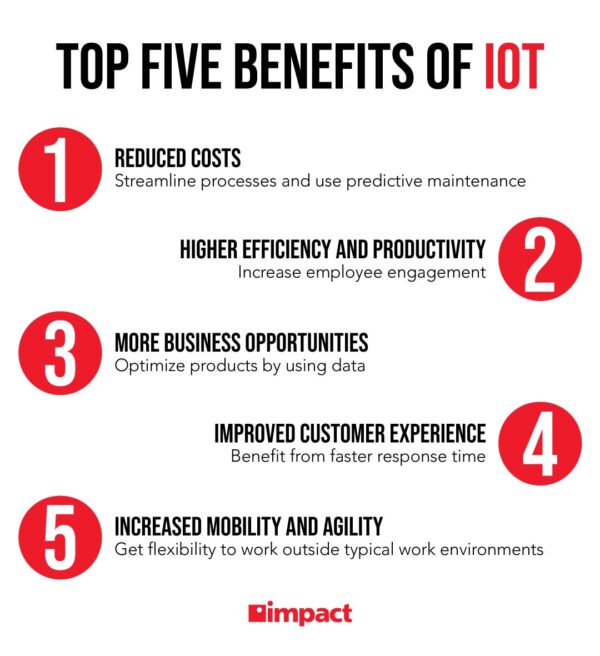The Internet of Things (IoT) is revolutionizing how businesses operate and interact with customers. IoT technology has the potential to drive significant cost savings, efficiency gains, customer insights, and more for companies that are willing to invest in it. In this article, we’ll take a look at how IoT is changing business.
As businesses look for ways to increase their competitive edge, many have realized that embracing this new era of digital transformation can provide them with a powerful advantage over competitors who don’t adopt IoT solutions. With so much opportunity available through implementing an effective IoT strategy, it’s good to learn how IoT is changing business.
Table of Contents
How Is IoT Changing Business?
How is IoT changing business? By connecting devices, machines, and systems, companies can collect data in real-time to make better decisions faster. This improved access to information has allowed businesses to improve customer experience and create new revenue opportunities.
Automation and Efficiency Gains
IoT technology enables companies to automate mundane tasks such as inventory management or supply chain tracking. Automating these processes reduces human error while also saving time and money for the business.
Additionally, business IoT allows for predictive maintenance which helps reduce downtime by identifying potential problems before they occur. These automation gains have enabled businesses to become more efficient with their operations while also reducing costs associated with manual labor or repairs due to machine failure.
Improved Customer Experience
With connected devices providing real-time data on customer interactions, businesses can better understand customer needs and preferences to provide a tailored experience that meets those needs.
For example, retailers can use this data from connected sensors placed throughout stores to track customers’ movements to determine how best to lay products out on shelves. It can even suggest what promotions should be offered at certain times of the day based on foot traffic patterns.
In addition, IoT technologies allow for personalized marketing campaigns that are sent directly into consumers’ homes through smart speakers or other connected devices like TVs or phones
Increased Revenue Opportunities
Connected devices enable companies not only to gather valuable insights about their customers but also to create new ways to generate revenue. This is more apparent in services such as subscription models or pay-per-use pricing structures.
For instance, an automobile manufacturer could offer a subscription service where customers pay a monthly fee for access to features like a navigation system instead of buying them outright.
Similarly, a company may charge its users per usage of its product instead one flat rate. This allows the company to capitalize on demand fluctuations without having to worry about changing prices constantly.

(Source)
Challenges Faced by Businesses Adopting IoT
When businesses adopt the Internet of Things (IoT), they must be aware of the challenges that come with it. Security concerns, cost implications, and data management issues are all potential obstacles to successful implementation.
Security Concerns
As IoT devices become increasingly connected, so do their security risks. Companies need to develop secure authentication protocols for device access and use encryption when transmitting data over networks.
Additionally, companies should consider investing in a comprehensive cybersecurity strategy that includes regular monitoring and updates to protect against malicious attacks or unauthorized access.
Cost Implications
Implementing an IoT solution can be expensive due to hardware costs as well as ongoing maintenance fees associated with keeping devices up-to-date and running smoothly.
Companies should carefully evaluate the total cost of ownership before making any investments to ensure they get a return on their investment.
Data Management Issues
With more data being collected from connected devices, businesses must have systems in place for managing this information effectively and securely.
This includes setting up databases for storing data as well as developing policies around how this information is used and shared internally or externally with third parties such as customers or partners.
Companies looking to implement an IoT solution should take into account these challenges before moving forward to ensure success down the line.
Proactive steps such as establishing clear goals and objectives, choosing the right technology platforms and partnerships, and developing an effective security plan upfront can set organizations up for long-term success with their IoT initiatives.
Examples of How IoT Is Changing Business
To learn more about how IoT is changing business, let’s look at specific examples.
Manufacturing Industry
Companies in the manufacturing industry are using industrial IoT to streamline their production processes.
For example, Ford Motor Company has implemented a connected factory system that uses sensors and robots to monitor and control its assembly lines. This allows them to quickly identify any problems or issues with their production process and make adjustments as needed.
Retail Industry
Retailers are leveraging IoT technology to improve customer experience. Amazon Go is an example of this, where customers can simply walk into a store, grab what they need, and leave without having to wait in line or go through checkout.
The stores use sensors throughout the store which detect when items have been taken off shelves so that customers can be charged for them automatically when they leave the store.
Healthcare
Healthcare providers are also taking advantage of IoT technology by connecting medical devices such as pacemakers and insulin pumps directly to patient records stored on cloud-based systems.
This allows doctors to access real-time data about their patient’s health status remotely, helping them provide better care more efficiently than ever before. Additionally, hospitals are using RFID tags attached to medical equipment like wheelchairs or IV stands which help track inventory levels so staff can easily locate items when needed.
Conclusion
How IoT is changing businesses is undeniable. By leveraging the power of connected devices, businesses can gain insights into customer behavior, automate processes, and increase efficiency.
However, companies need to understand the challenges associated with implementing an IoT solution to ensure a successful outcome. With careful planning and consideration of all aspects involved in adopting an IoT strategy, businesses can take advantage of this technology to drive growth and remain competitive in today’s digital world.





